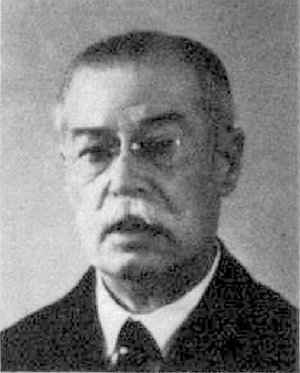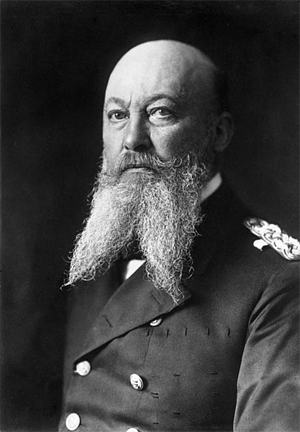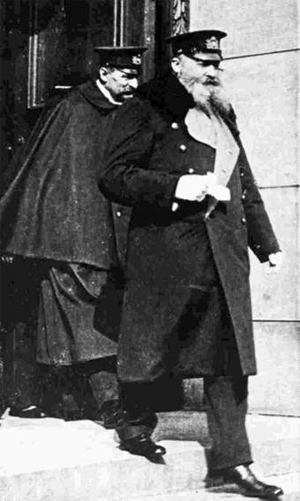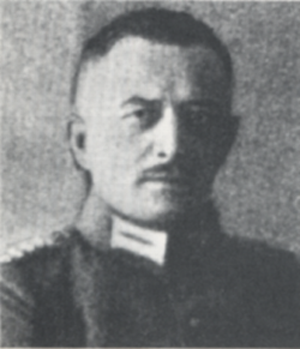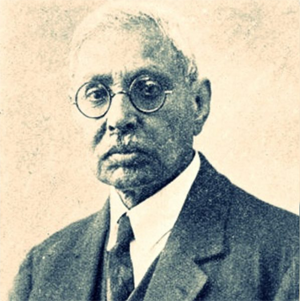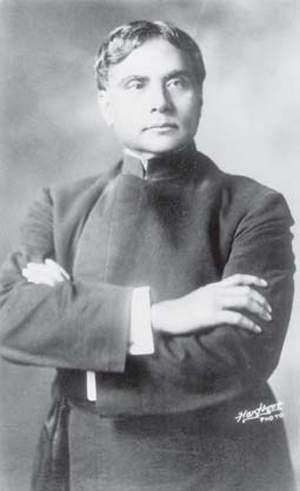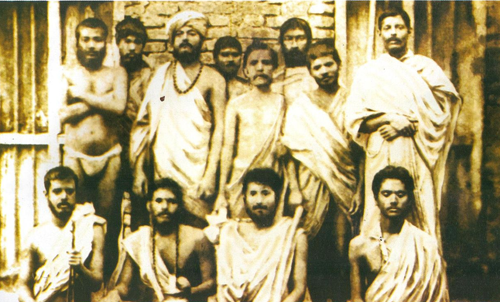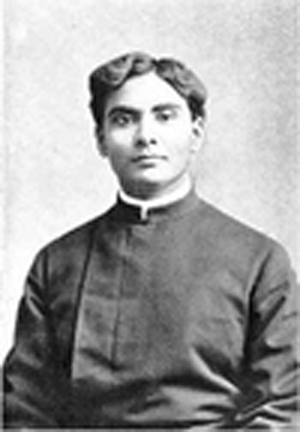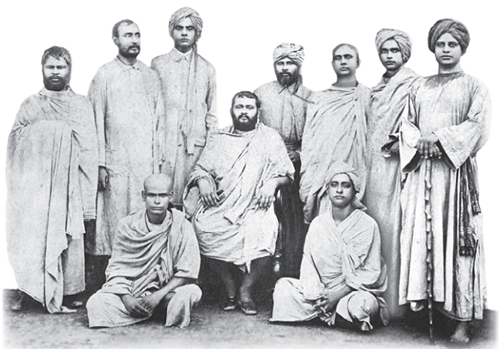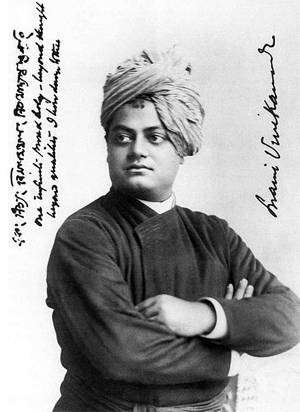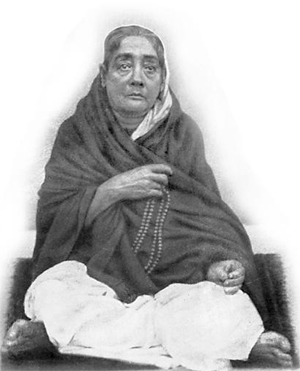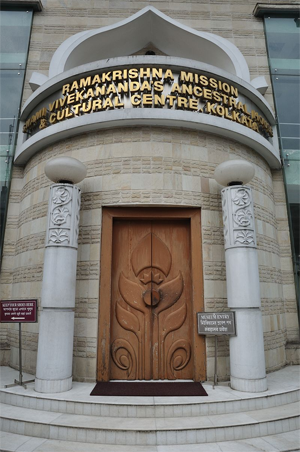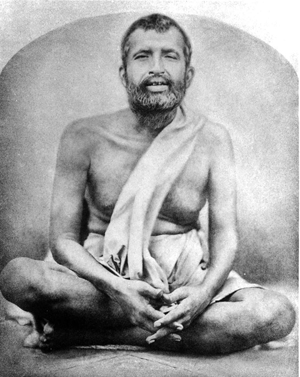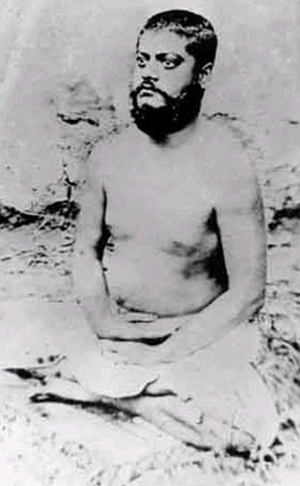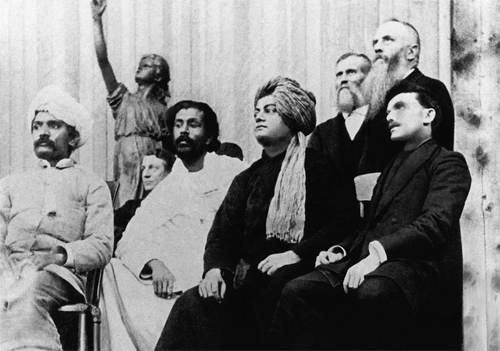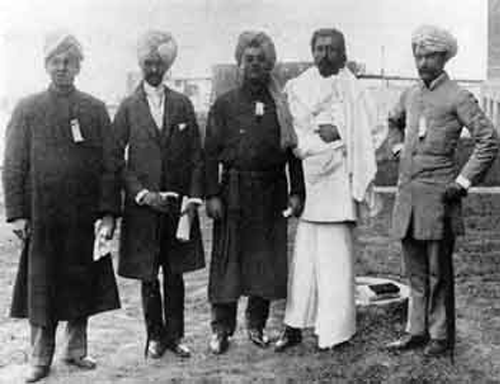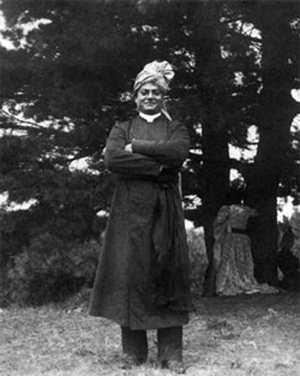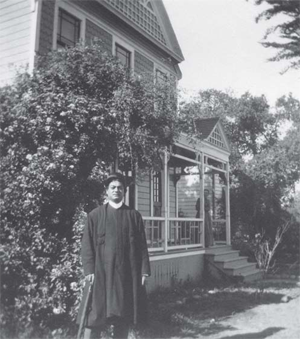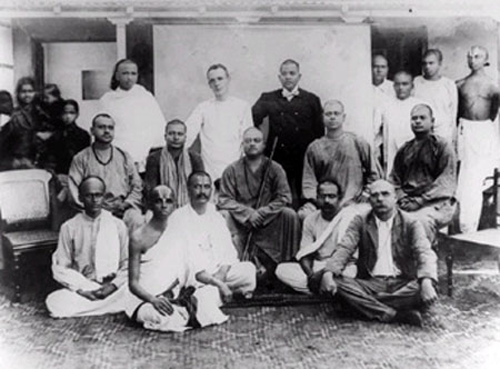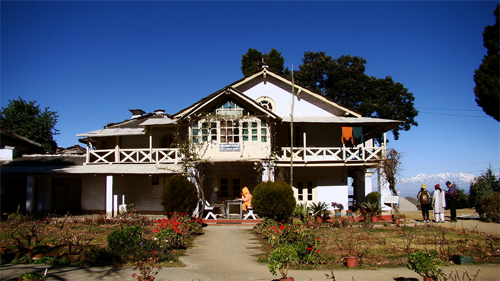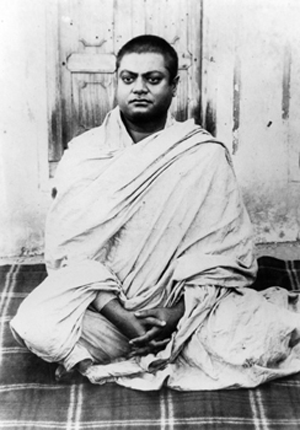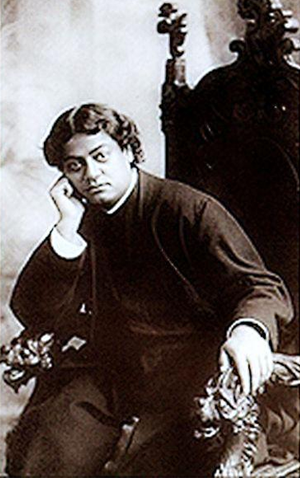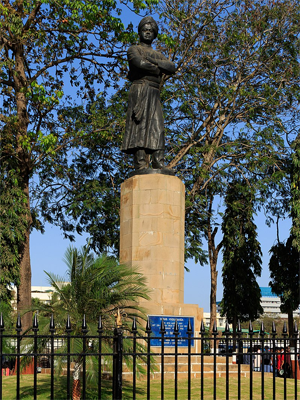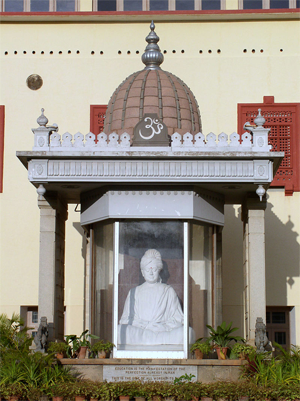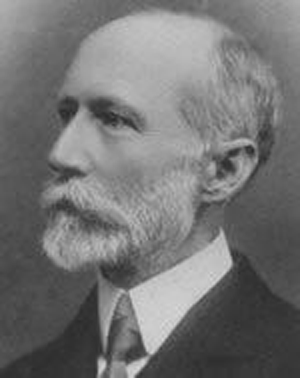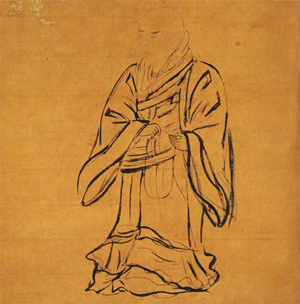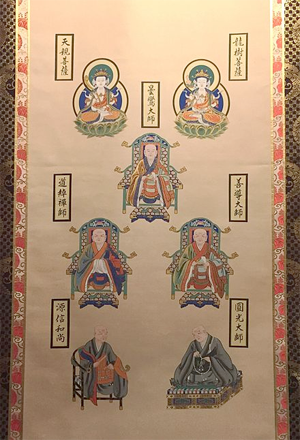Part 2 of 2
WorksMain article: Bibliography of Swami Vivekananda
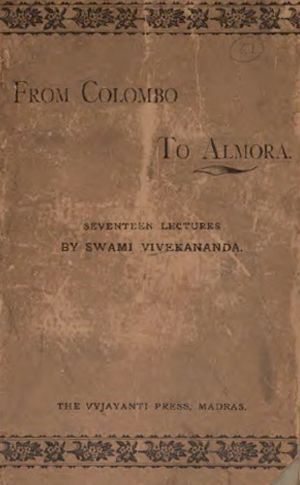 Lectures from Colombo to Almora front cover 1897 edition
Lectures from Colombo to Almora front cover 1897 edition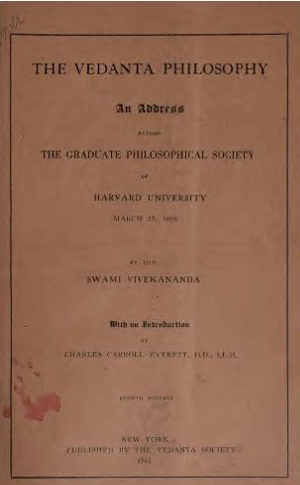 Vedanta Philosophy An address before the Graduate Philosophical Society 1901 cover pageLectures
Vedanta Philosophy An address before the Graduate Philosophical Society 1901 cover pageLecturesAlthough Vivekananda was a powerful orator and writer in English and Bengali,[199] he was not a thorough scholar,[200] and most of his published works were compiled from lectures given around the world which were "mainly delivered [...] impromptu and with little preparation".[200] His main work, Raja Yoga, consists of talks he delivered in New York.[201]
Literary worksAccording to Banhatti, "[a] singer, a painter, a wonderful master of language and a poet, Vivekananda was a complete artist",[202] composing many songs and poems, including his favourite,[citation needed] "Kali the Mother". Vivekananda blended humour with his teachings, and his language was lucid. His Bengali writings testify to his belief that words (spoken or written) should clarify ideas, rather than demonstrating the speaker (or writer's) knowledge.[citation needed]
Bartaman Bharat meaning "Present Day India"[203] is an erudite Bengali language essay written by him, which was first published in the March 1899 issue of Udbodhan, the only Bengali language magazine of Ramakrishna Math and Ramakrishna Mission. The essay was reprinted as a book in 1905 and later compiled into the fourth volume of The Complete Works of Swami Vivekananda.[204] In this essay his refrain to the readers was to honour and treat every Indian as a brother irrespective of whether he was born poor or in lower caste.[205]
Publications
Published in his lifetime[206]• Sangeet Kalpataru (1887, with Vaishnav Charan Basak)[79]
• Karma Yoga (1896)[207][208]
• Raja Yoga (1896 [1899 edition])[209]
• Vedanta Philosophy: An address before the Graduate Philosophical Society (1896)
• Lectures from Colombo to Almora (1897)
• Bartaman Bharat (in Bengali) (March 1899), Udbodhan
• My Master (1901), The Baker and Taylor Company, New York
• Vedânta philosophy: lectures on Jnâna Yoga (1902) Vedânta Society, New York OCLC 919769260
• Jnana yoga (1899)
Published posthumouslyHere is a list of selected books by Vivekananda that were published after his death (1902)[206]
• Addresses on Bhakti Yoga
• Bhakti Yoga
• The East and the West (1909)[210]
• Inspired Talks (1909)
• Narada Bhakti Sutras – translation
• Para Bhakti or Supreme Devotion
• Practical Vedanta
• Speeches and writings of Swami Vivekananda; a comprehensive collection
• Complete Works: a collection of his writings, lectures and discourses in a set of nine volumes (ninth volume will be published soon)
• Seeing beyond the circle (2005)
See also• List of Hindu gurus and saints
Notes1. The exact date of the meeting is unknown. Vivekananda researcher Shailendra Nath Dhar studied the Calcutta University Calendar of 1881—1882 and found in that year, examination started on 28 November and ended on 2 December[58]
2. A brother monk of Narendranath
3. On learning that Vivekananda lacked credentials to speak at the Chicago Parliament, Wright said "To ask for your credentials is like asking the sun to state its right to shine in the heavens".[97]
4. McRae quotes "[a] sectarian biography of Vivekananda,"[106] namely Sailendra Nath Dhar A Comprehensive Biography of Swami Vivekananda, Part One, (Madras, India: Vivekananda Prakashan Kendra, 1975), p. 461, which "describes his speech on the opening day".[107]
5. Brother monks or brother disciples means other disciples of Ramakrishna who lived monastic lives.
6. According to Michael Taft, Ramakrishna reconciled the dualism of form and formless,[167] regarding the Supreme Being to be both Personal and Impersonal, active and inactive.[web 1] Ramakrishna: "When I think of the Supreme Being as inactive – neither creating nor preserving nor destroying – I call Him Brahman or Purusha, the Impersonal God. When I think of Him as active – creating, preserving and destroying – I call Him Sakti or Maya or Prakriti, the Personal God. But the distinction between them does not mean a difference. The Personal and Impersonal are the same thing, like milk and its whiteness, the diamond and its lustre, the snake and its wriggling motion. It is impossible to conceive of the one without the other. The Divine Mother and Brahman are one."[web 1]
7. Sooklalmquoytes Chatterjee: "Sankara's Vedanta is known as Advaita or non-dualism, pure and simple. Hence it is sometimes referred to as Kevala-Advaita or unqualified monism. It may also be called abstract monism in so far as Brahman, the Ultimate Reality, is, according to it, devoid of all qualities and distinctions, nirguna and nirvisesa [...] The Neo-Vedanta is also Advaitic inasmuch as it holds that Brahman, the Ultimate Reality, is one without a second, ekamevadvitiyam. But as distinguished from the traditional Advaita of Sankara, it is a synthetic Vedanta which reconciles Dvaita or dualism and Advaita or non-dualism and also other theories of reality. In this sense it may also be called concrete monism in so far as it holds that Brahman is both qualified, saguna, and qualityless, nirguna (Chatterjee, 1963 : 260)."[168]
References1. "World fair 1893 circulated photo". vivekananda.net. Retrieved 11 April 2012.
2. Bhajanānanda (2010), Four Basic Principles of Advaita Vedanta, p.3
3. De Michelis 2005.
4. "Swami Vivekananda: A short biography".
http://www.oneindia.com. Retrieved 3 May 2017.
5. "Life History & Teachings of Swami Vivekanand". Retrieved 3 May 2017.
6. "International Yoga Day: How Swami Vivekananda helped popularise the ancient Indian regimen in the West". 21 June 2017.
7. Feuerstein 2002, p. 600.
8. Clarke 2006, p. 209.
9. Von Dense 1999, p. 191.
10. Dutt 2005, p. 121.
11. Virajananda 2006, p. 21.
12. Paul 2003, p. 5.
13. Banhatti, Gopal Shrinivas (1995). Life and philosophy of Swami Vivekananda. p. 1. ISBN 9788171562916.
14. Steven Kemper (2015). Rescued from the Nation: Anagarika Dharmapala and the Buddhist World. University of Chicago Press. p. 236. ISBN 9780226199108.
15. "Devdutt Pattanaik: Dayanand & Vivekanand". 15 January 2017.
16. Badrinath 2006, p. 2.
17. Mukherji 2011, p. 5.
18. Banhatti 1995, p. 1.
19. Badrinath 2006, p. 3.
20. Bhuyan 2003, p. 4.
21. Banhatti 1995, p. 2.
22. Nikhilananda 1964.
23. Sen 2003, p. 20.
24. Bhuyan 2003, p. 5.
25. Banhatti 1995.
26. Banhatti 1995, p. 4.
27. Arrington & Chakrabarti 2001, pp. 628–631.
28. Sen 2003, p. 21.
29. Sen 2006, pp. 12–14.
30. Sen 2003, pp. 104–105.
31. Pangborn & Smith 1976, p. 106.
32. Dhar 1976, p. 53.
33. Malagi & Naik 2003, pp. 36–37.
34. Prabhananda 2003, p. 233.
35. Banhatti 1995, pp. 7–9.
36. Chattopadhyaya 1999, p. 31.
37. K.R.Gupta; Amita Gupta, eds. (2006). Concise Encyclopaedia of India. Atlantic. p. 1066. ISBN 9788126906390.
38. G. S Banhatti (2015). Life And Philosophy Of Swami Vivekananda. Atlantic. pp. 156, 157. ISBN 9788171562916.
39. Swami Vivekananda's 114th death anniversary: Lesser known facts about the spiritual leader. India Today. 4 July 2016.
40. De Michelis 2005, p. 99.
41. De Michelis 2005, p. 100.
42. Banhatti 1995, p. 8.
43. Badrinath 2006, p. 20.
44. De Michelis 2005, p. 31-35.
45. De Michelis 2005, p. 19-90, 97–100.
46. Chattopadhyaya 1999, p. 29.
47. De Michelis 2005, p. 46.
48. De Michelis 2005, p. 46-47.
49. De Michelis 2005, p. 47.
50. De Michelis 2005, p. 81.
51. De Michelis 2005, p. 49.
52. Sen 2006, pp. 12–13.
53. De Michelis 2005, p. 50.
54. De Michelis 2005, p. 101.
55. Chattopadhyaya 1999, p. 43.
56. Ghosh 2003, p. 31.
57. Badrinath 2006, p. 18.
58. Chattopadhyaya 1999, p. 30.
59. Badrinath 2006, p. 21.
60. Paranjape 2012, p. 132.
61. Prabhananda 2003, p. 232.
62. Banhatti 1995, pp. 10–13.
63. Rolland 1929a, pp. 169–193.
64. Arora 1968, p. 4.
65. Bhuyan 2003, p. 8.
66. Sil 1997, p. 38.
67. Sil 1997, pp. 39–40.
68. Kishore 2001, pp. 23–25.
69. Nikhilananda 1953, pp. 25–26.
70. Sil 1997, p. 27.
71. Isherwood 1976, p. 20.
72. Pangborn & Smith 1976, p. 98.
73. Rolland 1929b, pp. 201–214.
74. Banhatti 1995, p. 17.
75. Sil 1997, pp. 46–47.
76. Banhatti 1995, p. 18.
77. Nikhilananda 1953, p. 40.
78. Chetananda 1997, p. 38.
79. Chattopadhyaya 1999, p. 33.
80. Bhuyan 2003, p. 10.
81. Rolland 2008, p. 7.
82. Dhar 1976, p. 243.
83. Richards 1996, pp. 77–78.
84. Bhuyan 2003, p. 12.
85. Rolland 2008, pp. 16–25.
86. Banhatti 1995, p. 24.
87. Gosling 2007, p. 18.
88. Bhuyan 2003, p. 15.
89. Paranjape 2005, pp. 246–248.
90. Badrinath 2006, p. 158.
91. De Michelis 2005, p. 110.
92. Marcus Braybrooke, Charles Bonney and the Idea for a World Parliament of Religions, The Interfaith Observer
93. Boston Collaborative Encyclopedia of Western Theology, World Parliament of Religions (1893)
94. De Michelis 2005, p. 111-112.
95. De Michelis 2005, p. 112.
96. Minor 1986, p. 133.
97. Bhuyan 2003, p. 16.
98. "When East Met West — in 1893". The Attic. Retrieved 5 November 2019.
99. Houghton 1893, p. 22.
100. Bhide 2008, p. 9.
101. Paul 2003, p. 33.
102. Banhatti 1995, p. 27.
103. Bhuyan 2003, p. 17.
104. Paul 2003, p. 34.
105. McRae 1991, p. 17.
106. McRae 1991, p. 16.
107. McRae 1991, p. 34, note 20.
108. McRae 1991, pp. 18.
109. Prabhananda 2003, p. 234.
110. Farquhar 1915, p. 202.
111. Sharma 1988, p. 87.
112. Adiswarananda 2006, pp. 177–179.
113. Bhuyan 2003, p. 18.
114. Thomas 2003, pp. 74–77.
115. Meena Agrawal (30 January 2008). Swami Vivekananda. Diamond Pocket Books. p. 49. ISBN 978-81-288-1001-5.
116. Vivekananda 2001, p. 419.
117. Gupta 1986, p. 118.
118. Isherwood & Adjemian 1987, pp. 121–122.
119. Banhatti 1995, p. 30.
120. Chetananda 1997, pp. 49–50.
121. "Swami Vivekananda Know Photos America 1893–1895". vivekananda.net. Retrieved 6 April 2012.
122. De Michelis 2005, p. 120.
123. De Michelis 2005, p. 119-123.
124. De Michelis 2005, p. 123-126.
125. De Michelis 2005, p. 125-126.
126. De Michelis 2005, p. 149-180.
127. Chetananda 1997, p. 47.
128. Burke 1958, p. 618.
129. Thomas 2003, pp. 78–81.
130. Wuthnow 2011, pp. 85–86.
131. Rinehart 2004, p. 392.
132. Vrajaprana 1996, p. 7.
133. Shack, Joan (2012). "A Monumental Meeting" (PDF). Sri Sarada Society Notes. Albany, New York. 18 (1).
134. Kattackal 1982, p. 219.
135. Majumdar 1963, p. 577.
136. Burke 1985, p. 417.
137. Sharma 1963, p. 227.
138. Sheean 2005, p. 345.
139. Sharma 1988, p. 83.
140. Banhatti 1995, pp. 33–34.
141. Dhar 1976, p. 852.
142. Bhuyan 2003, p. 20.
143. Thomas 1974, p. 44.
144. Miller 1995, p. 181.
145. Banhatti 1995, pp. 34–35.
146. Ganguly 2001, p. 27.
147. Kraemer 1960, p. 151.
148. Prabhananda 2003, p. 235.
149. Lulla, Anil Buddy (3 September 2007). "IISc looks to Belur for seeds of birth". The Telegraph. Retrieved 6 May 2009.
150. Kapur 2010, p. 142.
151. Virajananda 2006, p. 291.
152. Banhatti 1995, pp. 35–36.
153. Virajananda 2006, p. 450.
154. Banhatti 1995, pp. 41–42.
155. Banhatti 1995, p. xv.
156. Banhatti 1995, pp. 43–44.
157. Banhatti 1995, pp. 45–46.
158. Chattopadhyaya 1999, pp. 218, 274, 299.
159. Chattopadhyaya 1999, p. 283.
160. Banhatti 1995, p. 46.
161. Bharathi 1998b, p. 25.
162. Sen 2006, p. 27.
163. Virajananda 1918, p. 81.
164. Virajananda 2006, pp. 645–662.
165. "Towards the end".
http://www.ramakrishnavivekananda.info. Retrieved 11 March 2012.
166. Jackson 1994, pp. 33–34.
167. Taft 2014.
168. Sooklal 1993, p. 33.
169. Vivekananda 1996, pp. 1–2.
170. "Swami Vivekananda life and teaching". Belur Math. Archived from the original on 30 March 2012. Retrieved 23 March 2012.
171. Bhuyan 2003, p. 93.
172. Seifer 2001, p. 164.
173. Vivekananda 2001, Conversations and Dialogues, Chapter "VI – X Shri Priya Nath Sinha", Vol 5.
174. Kashyap 2012, p. 12.
175. Dutta 2003, p. 110.
176. Rambachan 1994, pp. 6–8.
177. Shattuck 1999, pp. 93–94.
178. Bharathi 1998b, p. 37.
179. Bharathi 1998b, pp. 37–38.
180. Bhide 2008, p. 69.
181. Parel 2000, p. 77.
182. Shetty 2009, p. 517.
183. "Swami Vivekananda". ramakrishna.eu.
184. "Celebration of anniversaries in 2013". UNESCO. Retrieved 8 March 2012.
185. Wolffe 2004, p. 158.
186. "Article on Swami Vivekananda". Retrieved 20 August 2011.
187. Nikhilananda 1953, p. 2.
188. Kak, S. (2017) Tesla, wireless energy transmission and Vivekananda. Current Science, vol. 113, 2207-2210.
189. "National Youth Day" (PDF). National Portal of India. Government of India. 10 January 2009. Retrieved 5 October 2011.
190. "Remembering Swami Vivekananda". Zee News.India. 11 January 2011. Retrieved 9 September2013.
191. "National implementation committee approves funds for Swami Vivekananda values' education project". Highbeam. 6 September 2010. Archived from the original on 10 May 2013. Retrieved 14 April 2012.
192. "Swami Vivekananda State Police Academy". Swami Vivekananda State Police Academy. Retrieved 9 January 2013.
193. "Chhattisgarh Swami Vivekananda Technical University". Csvtu.ac.in. 19 November 2012. Archived from the original on 15 January 2013. Retrieved 7 February 2013.
194. "Pranab hopes Raipur airport's new terminal will support Chhattisgarh's growth". The Hindu. Retrieved 7 February 2013.
195. "2013–14 Declared the Year for Skill Development of the Youth Parliamentary Consultative Committee Attached to Ministry of Youth Affairs & Sports Meets". PTI. Retrieved 3 March 2013.
196. "Year-long events to mark Vivekananda's 150th birthday". The Times of India. Retrieved 3 March2013.
197. Category:Swami Vivekananda on stamps. commons.wikimedia.org
198. Vivekananda. colnect.com
199. Das 1991, p. 530.
200. De Michelis 2005, p. 150.
201. De Michelis 2005, p. 149-150.
202. Banhatti 1963, p. 273.
203. Mittra 2001, p. 88.
204. Chattopadhyaya 1999, p. 118.
205. Dalal 2011, p. 465.
206. "Vivekananda Library online". vivekananda.net. Retrieved 22 March 2012.
207. De Michelis 2005, p. 124.
208. Kearney 2013, p. 169.
209. Banhatti 1995, p. 145.
210. Urban 2007, p. 314.
Sources
Printed sources• Adiswarananda, Swami, ed. (2006), Vivekananda, world teacher : his teachings on the spiritual unity of humankind, Woodstock, Vermont: SkyLight Paths Pub, ISBN 1-59473-210-8
• Arrington, Robert L.; Chakrabarti, Tapan Kumar (2001), "Swami Vivekananda", A Companion to the Philosophers, Blackwell Publishing, ISBN 978-0-631-22967-4
• Arora, V. K. (1968), "Communion with Brahmo Samaj", The social and political philosophy of Swami Vivekananda, Punthi Pustak
• Badrinath, Chaturvedi (2006). Swami Vivekananda, the Living Vedanta. Penguin Books India. ISBN 978-0-14-306209-7.
• Banhatti, G.S. (1995), Life and Philosophy of Swami Vivekananda, Atlantic Publishers & Distributors, p. 276, ISBN 978-81-7156-291-6
• Banhatti, G.S. (1963), The Quintessence of Vivekananda, Pune, India: Suvichar Prakashan Mandal, ASIN B0007JQX3M
• Bharathi, K.S. (1998b), Encyclopaedia of eminent thinkers, Vol.8: the political thought of Vivekananda, New Delhi: Concept Publishing Company, ISBN 978-81-7022-709-0
• Bhide, Nivedita Raghunath (2008), Swami Vivekananda in America, ISBN 978-81-89248-22-2
• Bhuyan, P. R. (2003), Swami Vivekananda: Messiah of Resurgent India, New Delhi: Atlantic Publishers & Distributors, ISBN 978-81-269-0234-7
• Burke, Marie Louise (1958), Swami Vivekananda in America: New Discoveries, Kolkata: Advaita Ashrama, ISBN 978-0-902479-99-9
• Burke, Marie Louise (1985), Swami Vivekananda in the West: New Discoveries (in six volumes) (3 ed.), Kolkata: Advaita Ashrama, ISBN 978-0-87481-219-0
• Chattopadhyaya, Rajagopal (1999), Swami Vivekananda in India: A Corrective Biography, Motilal Banarsidass, ISBN 978-81-208-1586-5
• Chetananda, Swami (1997). God lived with them: life stories of sixteen monastic disciples of Sri Ramakrishna. St. Louis, Missouri: Vedanta Society of St. Louis. ISBN 0-916356-80-9.
• Clarke, Peter Bernard (2006), New Religions in Global Perspective, Routledge
• Dalal, Roshen (October 2011). Hinduism: An Alphabetical Guide. Penguin Books India. ISBN 978-0-14-341421-6.
• Das, Sisir Kumar (1991), A History of Indian Literature: 1800–1910, Western impact : Indian response, Sahitya Akademi, ISBN 978-81-7201-006-5
• Von Dense, Christian D. (1999), Philosophers and Religious Leaders, Greenwood Publishing Group
• Dhar, Shailendra Nath (1976), A Comprehensive Biography of Swami Vivekananda (2 ed.), Madras, India: Vivekananda Prakashan Kendra, OCLC 708330405
• Dutta, Krishna (2003), Calcutta: a cultural and literary history, Oxford: Signal Books, ISBN 978-1-56656-721-3
• Dutt, Harshavardhan (2005), Immortal Speeches, New Delhi: Unicorn Books, p. 121, ISBN 978-81-7806-093-4
• Farquhar, J. N. (1915), Modern Religious Movements in India, London: Macmillan
• Ganguly, Adwaita P. (2001), Life and Times of Netaji Subhas: From Cuttack to Cambridge, 1897–1921, VRC Publications, ISBN 978-81-87530-02-2
• Feuerstein, Georg (2002), The Yoga Tradition, Delhi: Motilal Banarsidass
• Ghosh, Gautam (2003). The Prophet of Modern India: A Biography of Swami Vivekananda. Rupa & Company. ISBN 978-81-291-0149-5.
• Gokhale, B. G. (January 1964). "Swami Vivekananda and Indian Nationalism". Journal of Bible and Religion. Oxford University Press. 32 (1): 35–42. JSTOR 1460427.
• Gosling, David L. (2007). Science and the Indian Tradition: When Einstein Met Tagore. Routledge. ISBN 978-1-134-14333-7.
• Gupta, Raj Kumar (1986), The Great Encounter: A Study of Indo-American Literary and Cultural Relations, Delhi: Abhinav Publications, ISBN 978-81-7017-211-6, retrieved 19 December 2012
• Houghton, Walter Raleigh, ed. (1893), The parliament of religions and religious congresses at the World's Columbian exposition (3 ed.), Frank Tennyson Neely, OL 14030155M
• Isherwood, Christopher (1976), Meditation and Its Methods According to Swami Vivekananda, Hollywood, California: Vedanta Press, ISBN 978-0-87481-030-1
• Isherwood, Christopher; Adjemian, Robert (1987), "On Swami Vivekananda", The Wishing Tree, Hollywood, California: Vedanta Press, ISBN 978-0-06-250402-9
• Jackson, Carl T (1994), "The Founders", Vedanta for the West: the Ramakrishna movement in the United States, Indianapolis, Indiana: Indiana University Press, ISBN 978-0-253-33098-7
• Kashyap, Shivendra (2012), Saving Humanity: Swami Vivekanand Perspective, Vivekanand Swadhyay Mandal, ISBN 978-81-923019-0-7
• Kapur, Devesh (2010), Diaspora, development, and democracy: the domestic impact of international migration from India, Princeton, New Jersey: Princeton University Press, ISBN 978-0-691-12538-1
• Kattackal, Jacob (1982), Religion and ethics in Advaita, Kottayam, Kerala: St. Thomas Apostolic Seminary, ISBN 978-3-451-27922-5
• Kearney, Richard (13 August 2013). Anatheism: Returning to God After God. Columbia University Press. ISBN 978-0-231-51986-1.
• Kishore, B. R. (2001). Swami Vivekanand. Diamond Pocket Books. ISBN 978-81-7182-952-1.
• Kraemer, Hendrik (1960), "Cultural response of Hindu India", World cultures and world religions, London: Westminster Press, ASIN B0007DLYAK
• Majumdar, Ramesh Chandra (1963), Swami Vivekananda Centenary Memorial Volume, Kolkata: Swami Vivekananda Centenary, p. 577, ASIN B0007J2FTS
• Malagi, R.A.; Naik, M.K. (2003), "Stirred Spirit: The Prose of Swami Vivekananda", Perspectives on Indian Prose in English, New Delhi: Abhinav Publications, ISBN 978-81-7017-150-8
• McRae, John R. (1991), "Oriental Verities on the American Frontier: The 1893 World's Parliament of Religions and the Thought of Masao Abe", Buddhist-Christian Studies, University of Hawai'i Press, 11: 7–36, doi:10.2307/1390252, JSTOR 1390252.
• De Michelis, Elizabeth (8 December 2005). A History of Modern Yoga: Patanjali and Western Esotericism. Continuum. ISBN 978-0-8264-8772-8.
• Miller, Timothy (1995), "The Vedanta Movement and Self-Realization fellowship", America's Alternative Religions, Albany, New York: SUNY Press, ISBN 978-0-7914-2398-1
• Minor, Robert Neil (1986), "Swami Vivekananda's use of the Bhagavad Gita", Modern Indian Interpreters of the Bhagavad Gita, Albany, New York: SUNY Press, ISBN 978-0-88706-297-1
• Mittra, Sitansu Sekhar (2001). Bengal's Renaissance. Academic Publishers. ISBN 978-81-87504-18-4.
• Mukherji, Mani Shankar (2011), The Monk As Man: The Unknown Life of Swami Vivekananda, ISBN 978-0-14-310119-2
• Nikhilananda, Swami (April 1964), "Swami Vivekananda Centenary", Philosophy East and West, University of Hawai'i Press, 14 (1): 73–75, doi:10.2307/1396757, JSTOR 1396757.
• Nikhilananda, Swami (1953), Vivekananda: A Biography (PDF), New York: Ramakrishna-Vivekananda Center, ISBN 0-911206-25-6, retrieved 19 March 2012
• Pangborn, Cyrus R.; Smith, Bardwell L. (1976), "The Ramakrishna Math and Mission", Hinduism: New Essays in the History of Religions, Brill Archive
• Paranjape, Makarand (2005), Penguin Swami Vivekananda Reader, Penguin India, ISBN 0-14-303254-2
• Paranjape, Makarand R. (2012). Making India: Colonialism, National Culture, and the Afterlife of Indian English Authority. Springer. ISBN 978-94-007-4661-9.
• Parel, Anthony (2000), Gandhi, Freedom, and Self-Rule, ISBN 978-0-7391-0137-7
• Paul, Dr S. (2003). Great Men Of India : Swami Vivekananda. Sterling Publishers Pvt. Ltd. ISBN 978-81-207-9138-1.
• Prabhananda, Swami (June 2003), "Profiles of famous educators: Swami Vivekananda" (PDF), Prospects, Netherlands: Springer, XXXIII (2): 231–245.
• Rambachan, Anantanand (1994), The limits of scripture: Vivekananda's reinterpretation of the Vedas, Honolulu, Hawaii: University of Hawaii Press, ISBN 978-0-8248-1542-4
• Richards, Glyn (1996), "Vivekananda", A Source-Book of Modern Hinduism, Routledge, pp. 77–78, ISBN 978-0-7007-0317-3
• Rinehart, Robin (1 January 2004). Contemporary Hinduism: Ritual, Culture, and Practice. ABC-CLIO. ISBN 978-1-57607-905-8.
• Rolland, Romain (1929a), "Naren the Beloved Disciple", The Life of Ramakrishna, Hollywood, California: Vedanta Press, pp. 169–193, ISBN 978-81-85301-44-0
• Rolland, Romain (1929b), "The River Re-Enters the Sea", The Life of Ramakrishna, Hollywood, California: Vedanta Press, pp. 201–214, ISBN 978-81-85301-44-0
• Rolland, Romain (2008), The Life of Vivekananda and the Universal Gospel (24 ed.), Advaita Ashrama, p. 328, ISBN 978-81-85301-01-3
• Seifer, Marc (2001), Wizard: The Life and Times of Nikola Tesla : Biography of a Genius, Citadel, ISBN 978-0-8065-1960-9
• Sen, Amiya (2003), Gupta, Narayani (ed.), Swami Vivekananda, New Delhi: Oxford University Press, ISBN 0-19-564565-0
• Sen, Amiya (2006), Indispensable Vivekananda: anthology for our times, Orient Blackswan, ISBN 978-81-7824-130-2
• Sharma, Arvind (1988), "Swami Vivekananda's Experiences", Neo-Hindu Views of Christianity, Leiden, The Netherlands: Brill, ISBN 978-90-04-08791-0
• Sharma, Benishankar (1963), Swami Vivekananda: A Forgotten Chapter of His Life, Kolkata: Oxford Book & Stationary Co., ASIN B0007JR46C
• Shattuck, Cybelle T. (1999), "The modern period ii: forces of change", Hinduism, London: Routledge, ISBN 978-0-415-21163-5
• Sheean, Vincent (2005), "Forerunners of Gandhi", Lead, Kindly Light: Gandhi and the Way to Peace, Kessinger Publishing, ISBN 978-1-4179-9383-3
• Shetty, B. Vithal (2009), World as seen under the lens of a scientist, Bloomington, Indiana: Xlibris Corporation, ISBN 978-1-4415-0471-5
• Sil, Narasingha Prosad (1997), Swami Vivekananda: A Reassessment, Selinsgrove, Pennsylvania: Susquehanna University Press, ISBN 0-945636-97-0
• Sooklal, Anil (1993), "The Neo-Vedanta Philosophy of Swami Vivekananda" (PDF), Nidan, 5
• Taft, Michael (2014), Nondualism: A Brief History of a Timeless Concept, Cephalopod Rex
• Thomas, Abraham Vazhayil (1974), Christians in Secular India, Madison, New Jersey: Fairleigh Dickinson University Press, ISBN 978-0-8386-1021-3
• Thomas, Wendell (1 August 2003). Hinduism Invades America 1930. Kessinger Publishing. ISBN 978-0-7661-8013-0.
• Urban, Hugh B. (1 January 2007). Tantra: Sex, Secrecy, Politics and Power in the Study of Religion. Motilal Banarsidass Publisher. ISBN 978-81-208-2932-9.
• Virajananda, Swami, ed. (2006) [1910], The Life of the swami Vivekananda by his eastern and western disciples... in two volumes (Sixth ed.), Kolkata: Advaita Ashrama, ISBN 81-7505-044-6
• Virajananda, Swami (1918), The Life of the Swami Vivekananda, 4, Prabuddha Bharata Office, Advaita Ashrama, retrieved 21 December 2012
• Vivekananda, Swami (2001) [1907], Complete Works of Swami Vivekananda, 9 Volumes, Advaita Ashrama, ISBN 978-81-85301-75-4
• Vivekananda, Swami (1996), Swami Lokeswarananda (ed.), My India : the India eternal (1st ed.), Calcutta: Ramakrishna Mission Institute of Culture, pp. 1–2, ISBN 81-85843-51-1
• Vrajaprana, Pravrajika (1996). A portrait of Sister Christine. Calcutta: Ramakrishna Mission Institute of Culture. ISBN 978-8185843803.
• Wuthnow, Robert (1 July 2011). America and the Challenges of Religious Diversity. Princeton University Press. ISBN 978-1-4008-3724-3.
• Wolffe, John (2004). Religion in History: Conflict, Conversion and Coexistence. Manchester University Press. ISBN 978-0-7190-7107-2.
Web-sources1. "Sri Ramakrisha The Great Master, by Swami Saradananda, (tr.) Swami Jagadananda, 5th ed., v.1, pp.558–561, Sri Ramakrishna Math, Madras".
Further readingMain article: Bibliography of Swami Vivekananda
• Chauhan, Abnish Singh (2004). Swami Vivekananda: Select Speeches. Prakash Book Depot. ISBN 978-8179774663.
• Chauhan, Abnish Singh (2006). Speeches of Swami Vivekananda and Subhash Chandra Bose: A Comparative Study. Prakash Book Depot. ISBN 9788179771495.
• King, Richard (2002). Orientalism and Religion: Post-Colonial Theory, India and "The Mystic East". Routledge.
• Majumdar, R. C. (1999). Swami Vivekananda: A historical review. Calcutta: Advaita Ashrama.
• Rambachan, Anatanand (1994), The Limits of Scripture: Vivekananda's Reinterpretation of the Vedas, University of Hawaii Press
• Malhotra, Rajiv (2016). Indra's Net: Defending Hinduism's Philosophical Unity (revised ed.). Noida, India: HarperCollins Publishers India. ISBN 978-9351771791. ISBN 9351771792 (400 pages)
• Sharma, Jyotirmaya (2013). A Restatement of Religion: Swami Vivekananda and the Making of Hindu Nationalism. Yale University Press. ISBN 978-0-300-19740-2.
External links• Swami Vivekananda at Curlie
• Works about Vivekananda via the Open Library
• Works by Vivekananda via the Open Library
• Works by or about Swami Vivekananda at Internet Archive
• Works by Swami Vivekananda at LibriVox (public domain audiobooks)
• Biography at Belur Math's official website
• Complete Works of Vivekananda, Belur Math publication
